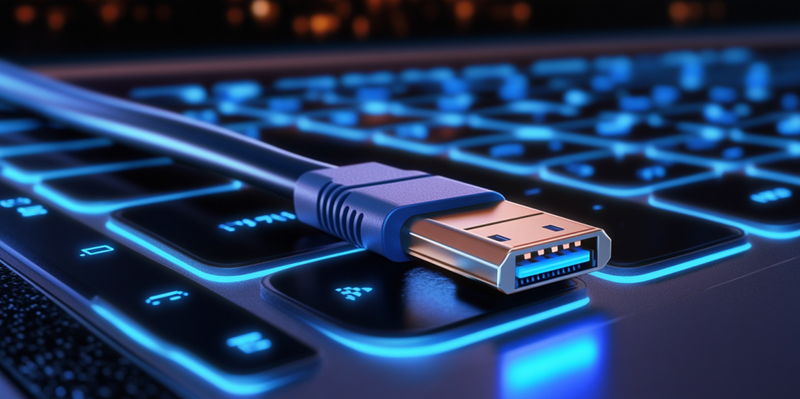In a significant technological leap, the Japanese manufacturer Elecom has announced the release of new USB4 2.0 cables, promising unprecedented data transfer speeds and power delivery capabilities. Set to be available in mid-December, these cables are expected to revolutionize the way modern electronic devices handle data and power. The USB4 2.0 standard succeeds the previous USB4, effectively doubling the transfer speed to a whopping 80 Gbps while also drastically increasing the power delivery capabilities to 240W. This advancement not only highlights the power of ongoing innovation in the tech world but also paves the way for more efficient and faster data management and charging solutions in various consumer electronics.
Elecom has successfully obtained certification for these groundbreaking cables, which will come in two variants. The first variant offers an impressive 80 Gbps transfer speed with a 60W power delivery capacity, while the second takes it even further, offering 80 Gbps alongside an astonishing 240W power delivery. This differentiation caters to varying needs and requirements, ensuring that both high-speed data transfer and high-capacity power delivery are adequately addressed. As technology continues to evolve, the need for such high-performance cables has become increasingly apparent, especially in fields requiring rapid data transfer and robust power support.
Enhanced Data Transfer and Power Delivery
The enhanced specifications of USB4 2.0 address many of the limitations found in previous USB standards, setting a new benchmark for what is possible in the realm of data transfer and power management. The doubling of transfer speeds to 80 Gbps is particularly notable, significantly outpacing the 40 Gbps limit of the original USB4. This kind of speed is critical in various applications, including high-resolution video editing, large file transfers, and complex computational tasks. With data-intensive tasks becoming more common, this increase in transfer speed is a timely advancement that will benefit both consumers and professionals alike.
Moreover, the boost in power delivery capabilities to 240W cannot be understated. This substantial increase is particularly important for devices that require more power to function optimally, such as gaming mini-PCs and other high-performance computing hardware. The 240W power delivery ensures that these devices can operate efficiently without the risk of underperformance or damage due to insufficient power supply. It also opens up new possibilities for device design, as manufacturers can now develop more powerful and feature-rich products knowing that the power delivery standards can support them.
Support for High-Resolution DisplayPort Passthrough
Another significant feature of the USB4 2.0 standard is its anticipated support for DisplayPort passthrough with resolutions of up to 8K at 60Hz. This effectively means that users will be able to enjoy ultra-high-definition visuals with seamless performance, making USB4 2.0 an ideal choice for those engaged in graphic design, video production, and gaming. The integration of such high-resolution support highlights the comprehensive nature of the USB4 2.0 standard, addressing both the need for rapid data transfer and superior visual capabilities in one cohesive package. This is likely to be a major selling point for consumers looking to future-proof their technology setups.
The importance of high-resolution DisplayPort passthrough cannot be overstated, as 8K displays become more mainstream and the demand for high-quality visual content continues to grow. Whether it’s streaming media, playing graphically intensive video games, or editing complex video projects, the USB4 2.0 standard ensures that users can achieve the highest possible visual performance without compromising on speed or power. As displays with higher resolutions become more common, the ability to support such high-quality visuals will be a critical feature for any future-proof technology.
Industry Adoption and Future Implications
The adoption of USB4 2.0 by key industry players signifies a broader trend toward more efficient and powerful data transfer methods. Microsoft’s ongoing tests for the integration of the USB4 2.0 standard in Windows 11 Insider Preview Build indicate that the technology giant is preparing to support this new standard in its operating system. This move underscores the critical importance of high-speed data transfer and robust power delivery in modern computing. It’s an alignment that promises to bring significant benefits to users, as the new standard will likely be integrated into a wide range of hardware and software environments.
Looking ahead, the implications of USB4 2.0’s adoption extend far beyond just faster data transfer and higher power delivery. The standard’s ability to support high-resolution DisplayPort passthrough and cater to the demands of high-performance devices positions USB4 2.0 as a cornerstone technology for the next generation of tech products. As more manufacturers and developers embrace this new standard, we can expect a surge in the development of devices that are not only more powerful but also more efficient and user-friendly. This is a testament to the relentless pace of innovation in the tech industry and a sign of exciting times ahead for consumers and professionals alike.
Conclusion: A Game-Changer in USB Technology
In a major technological advancement, Japanese company Elecom has unveiled its new USB4 2.0 cables, which offer unprecedented data transfer speeds and power delivery capabilities. Scheduled for release in mid-December, these cables are set to transform how modern electronic devices manage data and power. The USB4 2.0 standard, succeeding the previous USB4, doubles transfer speeds to an exceptional 80 Gbps and significantly enhances power delivery to 240W. This upgrade not only underscores the continuous innovation in the tech industry but also promises more effective and quicker data management and charging solutions across various consumer electronics.
Elecom has obtained certification for these state-of-the-art cables, available in two types. The first variant delivers an impressive 80 Gbps transfer speed with a 60W power delivery capacity, while the second variant goes further, offering the same 80 Gbps speed paired with a remarkable 240W power delivery. This range caters to different needs, ensuring both high-speed data transfer and substantial power delivery are met. As technology advances, the demand for high-performance cables has grown, especially in sectors needing fast data transfer and strong power support.

